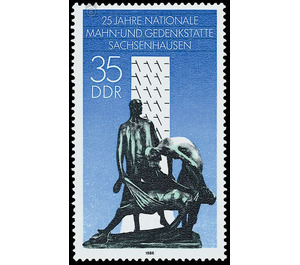Commemorative stamp series - Germany / German Democratic Republic 1986 - 35 Pfennig
Theme: Architecture
| Country | Germany / German Democratic Republic |
| Issue Date | 1986 |
| Face Value | 35.00 |
| Color | blue |
| Perforation | K 14 |
| Printing Type | Rotogravure 2 |
| Stamp Type | Postage stamp |
| Item Type | Stamp |
| Chronological Issue Number | 2793 |
| Chronological Chapter | GER-DDR |
| SID | 604464 |
| In 16 Wishlists | |
25 years Sachsenhausen reminder and memorial On the occasion of the 25th anniversary of the Sachsenhausen reminder and memorial, the Ministry of Posts and Telecommunications of the German Democratic Republic issues a multicolored postage stamp. Special cancellation from September 23 to November 22, 1986 The national reminder and memorial Sachsenhausen, north of Berlin, was inaugurated in April 1961. It is a place of memory of the victims of fascist barbarism, the heroes of the anti-fascist resistance struggle and the liberators, as well as a place of admonition. At the same place was one of the many fascist concentration camps between 1936 and 1945. Perverted sadists had become murderers of over 100,000 people from almost all European countries. Never will the cruelty of the Nazi tyrants extinguish from the memory of the peoples. The anti-fascists imprisoned there combined hatred and the will to resist fascist barbarism. They organized solidarity work under the terror conditions. And the German Communists were in the front row. As genuine internationalists, they maintained close contacts with all national groups, did systematic political education work and helped consolidate morale. The victories of the Soviet army, which proved effective as a source of strength, gave rise to this. At the end of April 1945, around 36,000 prisoners in columns of 500 each were sent eastwards with the intention of transporting them on ships and sinking them on the high seas. This death march on the streets, which led through the Brandenburg and Mecklenburg, claimed thousands of victims. The remaining prisoners were freed on 22 April 1945 by the Red Army. A week later, Soviet tankers freed shortly before Schwerin the prisoners on the death march. This was the end of the bloody fascist tragedy. More than eight million visitors from 142 countries have so far visited the National Remembrance and Memorial Center. Numerous exhibits in the storage museum give detailed information about life in the camp and the extermination of the prisoners.


